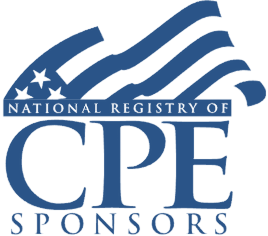Welcome! Save 30% on all CLE, CPE, and Professional Skills webinars, plus 15% off any annual pass with code HOLIDAY25
About the Course
Introduction
This course will explain how to calculate losses under new Section 461(l) and report these losses on Form 461. The panel will discuss what is and is not trade or business income, capital gains and losses to include in the calculation, calculating loss carryforwards, and completing Form 461 with needed clarifications.
Description
According to the IRS, though Form 461 doesn't exist for 2020, it will be issued beginning 2021.
Once gone, but now back, Form 461 per IRC Section 461(l) disallows excess business losses for noncorporate taxpayers. Excess business losses are those above $250,000 ($500,000 for joint taxpayers) after combining all income and losses from all trades or businesses for a taxpayer. This limitation is in addition to and after the passive loss and at-risk limitations already imposed on business losses.
Losses from flow-through entities combine with Schedule C and other individual income and losses on the individual shareholder's or partner's return. Net operating loss carryforward deductions are limited to 80 percent of taxable income or the carryover amount, whichever is less.
The form itself is only 16 lines, and the instructions are just two pages. Fourteen of the amounts on the 16 lines come directly from the 1040 or are simple calculations from preceding lines. On line 10, however, you enter income not attributable to a trade or business, and on line 11, you enter deductions not attributable to a trade or business. Understanding what to include on these two lines is key to calculating the allowed loss.
Adding to the complexity of this calculation is that explicitly following the instructions for inputting capital losses on Form 461 will, in some cases, generate a different result than intended under Section 461(l).
Listen as our panel of experts explains the amounts included on Form 461, the intentions of Section 461(l), carrying over business losses, and handling the related ambiguities.
Presented By

Mr. Carter is the Assistant Practice Director for True Partners Consulting in the Chicago office. He has over 16 years of experience advising clients on federal, state and international tax matters. Mr. Carter manages tax compliance and consulting engagements for large and mid-size corporations, S corporations and partnerships. His primary focus is on federal and international tax compliance, tax planning, accounting for income taxes (ASC 740), audit defense and tax research assistance. Mr. Carter’s experience includes consulting on M&A transactions, corporate restructurings, tax controversies and tax technology software implementations.
Mr. Johnson is Manager at the Chicago office of True Partners Consulting and an Illinois CPA with seven years of experience working primarily in pass-through and individual tax compliance. His clients vary from operating companies in the healthcare and software fields, to private equity firms and their partners. Mr. Johnson’s individual tax experience includes high net-worth individuals and large families with extensive filings including individuals, trusts, foundations, and multi-purpose entities.
-
BARBRI is a NASBA CPE sponsor and this 110-minute webinar is accredited for 2.0 CPE credits.
-
BARBRI is an IRS-approved continuing education provider offering certified courses for Enrolled Agents (EA) and Tax Return Preparers (RTRP).
Date + Time
- event
Tuesday, May 10, 2022
- schedule
1:00 p.m. ET./10:00 a.m. PT
- Section 461(l)
- Calculating excess business losses
- Defining trade or business under 461(l)
- Capital gains and losses under 461(l)
- Carryforward calculations
- Completing Form 461
- Questions surrounding 461(l)
- Impending legislation
The panel will review these and other essential matters:
- How is excess business income calculated?
- What constitutes a trade or business under Section 461(l)?
- Which capital gains and losses are included on Form 461?
- What is reported on Lines 10 and 11 on Form 461?
Learning Objectives
After completing this course, you will be able to:
- Determine how the excess business loss is calculated
- Establish how the elimination of NOL carrybacks impact non-corporate businesses and how to take advantage of the indefinite carryforward period
- Recognize how the 20 percent qualified business income deduction applies
- Identify the interaction of IRC 199A deduction with an excess business loss
- Verify that Form 461 is appropriately completed to account for business losses
- Field of Study: Taxes
- Level of Knowledge: Intermediate
- Advance Preparation: None
- Teaching Method: Seminar/Lecture
- Delivery Method: Group-Internet (via computer)
- Attendance Monitoring Method: Attendance is monitored electronically via a participant's PIN and through a series of attendance verification prompts displayed throughout the program
- Prerequisite: Three years+ business or public firm experience preparing complex tax forms and schedules, supervising other preparers or accountants. Specific knowledge and understanding of pass-through taxation, including taxation of partnerships, S corporations and sole proprietorships, qualified business income, net operating losses and loss limitations; familiarity with net operating loss carry-backs, carry-forwards and carried interests.

BARBRI, Inc. is registered with the National Association of State Boards of Accountancy (NASBA) as a sponsor of continuing professional education on the National Registry of CPE Sponsors. State boards of Accountancy have final authority on the acceptance of individual courses for CPE Credits. Complaints regarding registered sponsons may be submitted to NASBA through its website: www.nasbaregistry.org.

BARBRI is an IRS-approved continuing education provider offering certified courses for Enrolled Agents (EA) and Tax Return Preparers (RTRP).

BARBRI CE webinars-powered by Barbri-are backed by our 100% unconditional money-back guarantee: If you are not satisfied with any of our products, simply let us know and get a full refund. Contact us at 1-800-926-7926 .
Unlimited access to premium CLE courses:
- Annual access
- Available live and on-demand
- Best for attorneys and legal professionals
Unlimited access to premium CPE courses.:
- Annual access
- Available live and on-demand
- Best for CPAs and tax professionals
Unlimited access to premium CLE, CPE, Professional Skills and Practice-Ready courses.:
- Annual access
- Available live and on-demand
- Best for legal, accounting, and tax professionals
Unlimited access to Professional Skills and Practice-Ready courses:
- Annual access
- Available on-demand
- Best for new attorneys
Related Courses

Partnership Terminations: Sale or Abandonment of an Interest, Retirement or Death of Partner, and Closing the Entity
Wednesday, February 18, 2026
1:00 p.m. ET./10:00 a.m. PT

UK-Based Retirement Accounts for U.S. Taxpayers: Mastering Reporting, Maximizing Planning Opportunities
Tuesday, January 27, 2026
1:00 p.m. ET./10:00 a.m. PT

Tax Research Techniques: Internet Tools, AI Caveats, Methodology, Documentation and Communication of Results
Wednesday, January 21, 2026
1:00 p.m. ET./10:00 a.m. PT

The Impact of OBBBA on Trusts and Estates: New Planning Opportunities
Monday, January 26, 2026
1:00 p.m. ET./10:00 a.m. PT
Recommended Resources

How CPE Can Bridge the Gap Between What You Know and What You Need to Know
- Career Advancement


